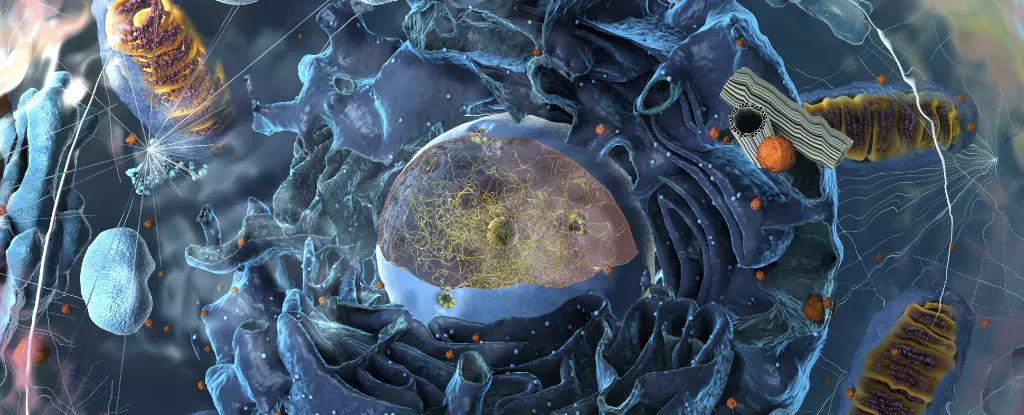Many of us remember our high school biology classes, where we learned about the basic components of cells. These lessons primarily focused on membrane-bound organelles—tiny structures within cells, each with specific functions. Mitochondria provide energy, ribosomes synthesize proteins, and lysosomes offer recycling services. For a long time, this membrane-centric view dominated our understanding of cell organization. However, scientific exploration has unveiled a new horizon—membraneless organelles, known scientifically as biomolecular condensates, which challenge traditional notions and offer a fresh perspective on cellular function.
The idea of membraneless organelles began to take shape in the mid-2000s, prompting researchers to reconsider what constitutes an organelle. In stark contrast to their membrane-bound counterparts, these condensates emerge not from defined boundaries but rather from the spontaneous assembly of proteins and RNA molecules. These condensates resemble the behavior of hot wax in a lava lamp as they fuse, separate, and recombine. Rather than relying on physical membranes to create compartments, these structures rely on specific interactions among molecular components.
The uniqueness of biomolecular condensates lies in their creation of localized microenvironments within cells. Current research suggests that around 30 types of these condensates exist, compared to just a dozen types of conventional membrane-bound organelles. But while identifying these structures has become easier, deciphering their specific roles remains a challenge. Many of these condensates serve well-defined functions, such as forming stress granules or reproductive cells; however, others display ambiguous roles that are as yet unexplained.
Traditionally, a fundamental principle in biochemistry has been that protein structure defines protein function. This mantra, grounded in discoveries dating back to the 1950s, asserts that proteins must possess a specific shape to complete their tasks effectively. Biomolecular condensates put this theory to the test, as they often comprise intrinsically disordered proteins (IDPs)—molecules lacking a defined structure. Initially perplexing to scientists, these IDPs demonstrate that a lack of rigidity does not exclude proteins from performing essential functions.
The relationship between IDPs and biomolecular condensates has suggested that these unstructured proteins may contribute to cellular processes in an array of innovative ways, initiating a renewed quest for understanding their behaviors. The enigma surrounding IDPs has prompted a deeper inquiry into the implications of membraneless structures and how they could potentially reshape our comprehension of cellular biology.
In a surprising turn, researchers have also identified biomolecular condensates within prokaryotic cells—bacteria that had been historically characterized as devoid of organelles. This revelation is noteworthy, as it reveals a level of complexity within bacterial life previously underestimated. It has been found that prokaryotic cells harbor multiple biomolecular condensates involved in fundamental cellular functions, such as RNA metabolism. This suggests that the classification system we use to differentiate cellular life forms may need an overhaul.
While only a small percentage of bacterial proteins consist of disordered regions (around 6%), their presence alongside biomolecular condensates signifies that prokaryotic cells can engage in far more intricate processes than previously acknowledged. Thus, the characterization of prokaryotes as simplistic structures must be reconsidered in light of this new evidence.
The investigation into biomolecular condensates opens up exciting discussions regarding the origins of life on Earth. Traditional hypotheses suggest that the earliest life forms required membrane structures to survive. However, recent findings indicate that RNAs could spontaneously form condensates without the need for lipid membranes. This groundbreaking perspective simplifies our understanding of how life can potentially emerge from nonliving elements through natural processes.
Furthermore, the notion of RNA existing in a state conducive to forming protocellular structures adds credence to the RNA world hypothesis. This concept posits that RNA, as a self-replicating molecule, could represent the initial stages of life, revolutionizing how we think about life’s biochemical origins.
Given the tremendous implications of biomolecular condensates, researchers are now exploring their relevance in understanding diseases, including neurodegenerative disorders like Alzheimer’s and Huntington’s disease. The hope is to develop innovative therapeutic strategies that manipulate these structures for treatment.
A future where every identified biomolecular condensate is assigned a unique function would certainly reshape the biological curriculum and inspire new generations of students. The potential to transform our views on cellular biology through these discoveries could be monumental, expanding the scope of genetics, biochemistry, and evolutionary biology.
The study of biomolecular condensates is redefining our understanding of cells and their functions. As science continues to uncover the mysteries of these membraneless structures, who knows how many more secrets about life itself are waiting to be uncovered?

